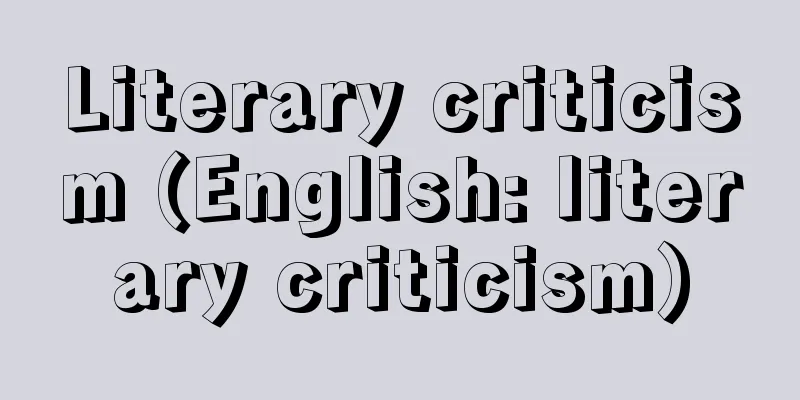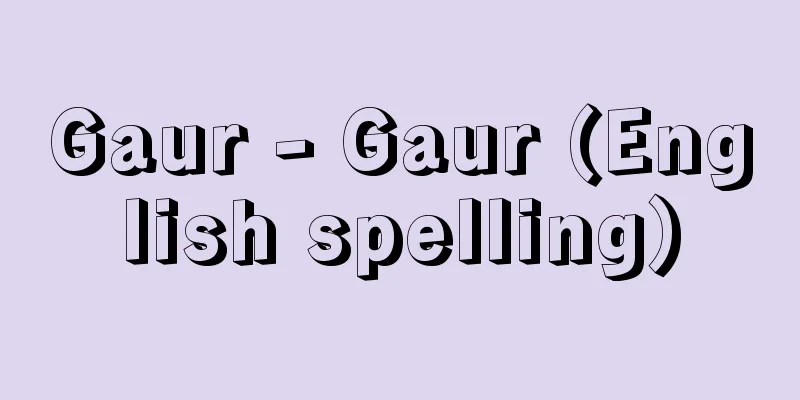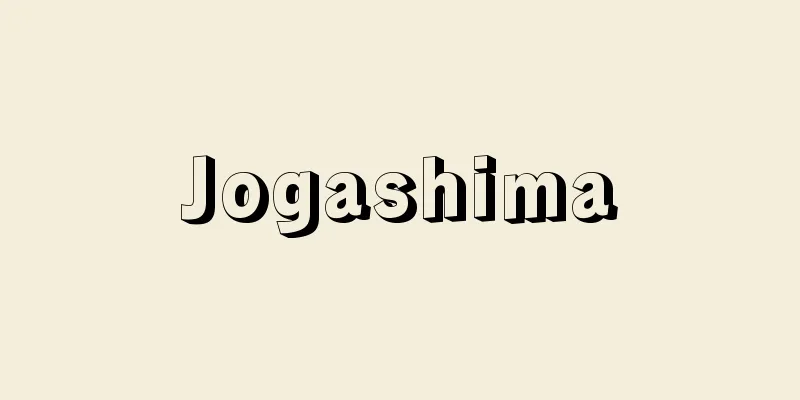Literary criticism (English: literary criticism)

|
Analysing the impression and emotion that a literary work gives to the reader, and making a value judgement of the literary work in light of the ideals of its creation, as well as a written version of this judgement. [Kobayashi Roichi] Historical changesThe historical evolution of literary criticism is extremely complex and its definitions vary widely, but if we look at its most prominent trends, we can roughly diagram them into the following three major oppositions. [Kobayashi Roichi] Judgmental Criticism and Impressionistic CriticismThere are two types of criticism: judicial criticism, which evaluates works based on some predetermined objective standard, and impressionistic criticism, which does not use a ready-made standard and instead judges works based on the reader's subjective likes and dislikes and impressions. The most traditional objective standard in critical criticism is ideal beauty, and since Aristotle attributed the characteristics of Greek drama and poetry in his Poetics, classical aesthetics was refined and perfected in Boileau's Act of Poesy (1674). In 17th century France, there were detailed rules and restrictions on tragedy, especially regarding the subject matter, characters, number of acts, vocabulary, and so on, including the "rule of three unities" that stipulated unity of plot, time, and place. Corneille, who wrote "Le Cid" in a slight departure from this, received severe social sanctions, partly due to jealousy over Corneille's great success. This ruthless condemnation is likened to the Greek myth of Procrustes, who made travelers lie on his bed, cutting off their legs if they were too tall, and lengthening their legs to the length of the bed if they were too short. In modern times, with the emergence of a new worldview, this concept of absolute beauty and its shackles (strict restrictions) naturally collapsed, and in the chaos created by the differentiation of individual literary activities and the diversification of values, people began to wander in search of some kind of solid standard to replace absolute beauty. The demand for these new standards and dogmas remained strong, especially among so-called lecture critics who taught at universities. Amid the rise of scientism and positivism in the 19th century, Taine attempted to define authors and their works in terms of the three major elements of lineage, environment, and opportunity (environmental theory), Bruntiere modeled his theory of the evolution of literary genres after Darwin, and Freud based his criticism on unconscious libido. Impressionistic criticism also has a long history, and has produced a continuous stream of excellent works that are worth savouring. However, as is typical of Zoilos (4th century BC), who attacked Homer, it has also often expressed jealousy and malice toward famous authors. Modern impressionistic criticism is based on good sense and calm, but while it claims to talk about authors and their works, it tends to be more of a personal taste and emotional outpouring, and does not consider those who lack justification for their evaluation of the subject. The fierce debate between Brunthière, who exploited this weakness, and impressionistic critics such as Anatole France and Lemaître, ultimately fell apart, and criticism has been polarized to this day. [Kobayashi Roichi] Utility criticism and aesthetic criticismAristotle believed that the function of literature was catharsis (emotional purification), but the expectation that literature has some practical benefit has persisted and occupies a corner of criticism ever since. This tendency is particularly strong among those involved in politics, religion, and education, and the more faithful they are to their own beliefs, the more they see literary works as tools for indoctrination rather than autonomy. Mao Zedong's "Lectures on the Literary Arts" (1942), the Vatican's "Index of Prohibited Books" (1564-1965), the trial and banning of literature by public authorities, and the expulsion of authors from the country are some extreme examples of this, but many Marxist materialists seek in literature a practical method for breaking through reality, and strict religious people and educators frown upon obscene and non-ascetic literature. Although Arnold had a great interest in culture and education, he considered the mission of criticism to be to protect literature from Puritan prejudice, because at heart he was a utilitarian critic, the polar opposite of Puritanism. Literary scholars generally do not like to subordinate literature to any utilitarian standards other than literature. Thus, the majority of professional critics in the world belong to the category of aesthetic critics to a greater or lesser extent. However, even in such cases, there is sometimes a higher level of aesthetic criticism, which is the so-called "art for art's sake" (Gautier) versus "art for life's sake" (Tolstoy), in other words, the view of life supremacy or humanitarian literature against art supremacy. It is a big question whether art, especially literature, should be placed above or below life, and at one extreme there is Futabatei Shimei, who said, "Literature is not a man's lifelong occupation," and at the other extreme there is Akutagawa Ryunosuke, who said, "Life is not even as young as a line of Baudelaire." Tolstoy, Belinsky, Chernyshevsky, Romain Rolland, and the Shirakaba School belong to the former, while Poe, Gautier, Baudelaire, Pater, Wilde, and essays by aesthetic writers such as Tanizaki Junichiro, Sato Haruo, and Mishima Yukio belong to the latter. [Kobayashi Roichi] Traditional Criticism and New CriticismWhile premodern classical criticism clearly showed a tendency toward universality based on reason and destiny, post-Romantic criticism has emphasized the superiority of sensibility and the individuality and peculiarity of each individual, so it has inevitably become more interesting in the author behind the literary work than in the work itself. The idea is that the work itself does not have a life, but that it is the human author who gives life to the work. Sainte-Beuve said, "From this tree, from this fruit," and considered the author and the work to be inseparably linked, and tried to elucidate the work through the author's real life. According to him, conventional critics also acknowledged the existence of the author, but this was merely a fantasy based on the work, and the image of the author was inevitably distorted. So he collected materials, even fragments and ink, and approached the real image of the author without any preconceptions. "After immersing yourself in the works and materials of a great writer for about two weeks, the vague outlines of the work gradually become clearer and more individual. When you become aware of the writer's habits, smiles, old scars, and wrinkles under his hair, all individual analysis disappears, the whole comes to life, and the writer speaks to you of his own accord." The distinctive feature of Sainte-Beuve's criticism is that he delves deeper into the conventional subjective impression criticism by adding the study of objective facts, and combines observation, psychological insight, and explanation. This is why he is called the father of modern criticism, and through him, criticism was elevated to a literary genre on a par with novels, poetry, and drama. The mainly positivist aspects of his method were passed down to Taine, Renan, Brandes, Brunthière, Ranson, and others as scientific criticism, while the aesthetic aspects were passed down to Arnold, Pater, Anatole France, Kobayashi Hideo, and others as appreciative criticism. Furthermore, from the former came Marxist literary sociological criticism, which would later lead to the defense and development of proletarian literature, psychoanalytic criticism by Freud, Jung, Botkin, and others, and idealistic historical criticism by Croce, which in turn promoted the birth of literary history research and literary studies. Furthermore, the involvement of writers in their inner lives continued to deepen, leading to Alain, Thibaudet, Du Bos, Bachelard, Poulet, and Sartre, who saw "existence" in the depths of human existence. However, in the early 20th century, Valéry, Proust, T.S. Eliot, Richards, Empson and others opposed Sainte-Beuve's biographical criticism, and, contrary to his, separated the work from the author, and took the position that a literary work is a completely autonomous whole, unrelated to any external elements. "Homer's biography is not well understood, but this does not diminish the beauty of the sea in the Odyssey" (Valéry). This way of thinking developed into the "New Criticism" in the United States from the 1930s onwards, and became the catalyst for the formation of the third wave in the history of criticism, which could be called symbolist criticism, following classical criticism and romantic criticism. This criticism was characterized by the objective analysis of images and the development of original critical terminology to conceptualize them, but it declined due to an excessive focus on images, and was eventually replaced by the formalist criticism of the Prague School led by Jakobson and the French structuralist criticism led by Roland Barthes. The characteristic of these broadly defined "new criticisms" is that they all seek to clarify the unconscious and latent linguistic characteristics and structure of literary works (texts) without taking into account the intentions of the author, and they often draw on a variety of disciplines, including philosophy, psychoanalysis, cultural anthropology, folklore, linguistics, semantics, stylistics, and semiotics, and are generally extremely difficult to understand, with a stronger literary and poetic flavor than literary criticism. [Kobayashi Roichi] present dayThe cutting edge of contemporary criticism continues to be dominated by this emphasis on text, and in particular the idea of denying the self-containedness of literary works. In other words, the idea of the text being an incomplete thing that should be transformed into a higher-level text through the cooperation of the act of creation and the act of reading, or something that should be reconstructed (Barthes in his later years and poststructuralism), the view of it as a comprehensive composition (Kristeva's intertextuality), and even the view that literature only comes into being when each reader destroys the hardened text from within (deconstructive criticism). In addition, the scope of literary criticism is expanding with the mixture of traditional criticism in the style of Dryden, S. Johnson, Sainte-Beuve, and Baudelaire, the New Literary Manifesto, and the claims for the integration, eclecticism, and proper use of various types of criticism, theories of the reader, theories of literary pleasure, theories of literary space, and literary agnosticism. [Kobayashi Roichi] Literary Criticism by Carloni and Filloux, translated by Hiraoka Noboru (1956, Hakusuisha) ▽ Principles of Literary Criticism by Richards, translated by Iwasaki Muneharu (1963, Tarumi Shobo) ▽ The Physiology of Criticism by Thibaudet, translated by Toda Yoshinobu (1969, Fuyukisha) ▽ Methods of Criticism by Hyman, edited by Toyama Shigehiko, 12 volumes (1974, Taishukan Shoten) ▽ New Perspectives on Literary Criticism by Brunel et al., translated by Hiraoka Noboru and Kawanako Hiroshi (1985, Hakusuisha) ▽ French Literature and Criticism by Fayolle, translated by Ohno Keiichiro et al. (1986, Sanshusha) ▽ An Introduction to Literary Criticism by Gerin et al., translated by Kusaka Yosuke and Aoki Ken (1986, Sairyusha) ▽ "Twentieth Century Literary Criticism" by Jean-Yves Tadier, translated by Nishinaga Yoshinari, Yamamoto Shinichi, and Asakura Fumihiro (1993, Taishukan Shoten)" ▽ "Contemporary Literary Criticism: Theory and Practice" by R. Selden, translated by Suzuki Ryohei (1994, Sairyusha)" ▽ "Contemporary Literary Theory: Text, Reading, and World" by Tsuchida Tomonori et al. (1996, Shinyosha)" ▽ "What is Literature? An Invitation to Contemporary Critical Theory" by T. Eagleton, translated by Ohashi Yoichi, new edition (1997, Iwanami Shoten)" ▽ "The Latest Dictionary of Literary Criticism" edited by Kawaguchi Kyoichi and Okamoto Yasumasa (1998, Kenkyusha)" ▽ "Can Gender Be Transcended? Toward a New Literary Criticism" edited by Takeda Yuichi (2000, Sairyusha) [References] | | | | | | | | | | | | | | | |Source: Shogakukan Encyclopedia Nipponica About Encyclopedia Nipponica Information | Legend |
|
文学作品が読者に与える印象・感動を分析し、それを創作の理想に照らして文学作品の価値判断を行うこと、およびその文章化されたもの。 [小林路易] 歴史変遷文芸批評の歴史的変遷はきわめて複雑で、その定義づけも甚だ多岐にわたるが、その顕著な趨勢(すうせい)を取り上げると、おおよそ次の三大対立に図式化することができよう。 [小林路易] 裁断批評と印象批評あらかじめ定められたなんらかの客観的規準によって評価を下す裁断批評judical criticismと、できあいの尺度を用いずに、読者個人の主観的な好悪や印象に基づいて判断する印象批評impressionistic criticism。裁断批評における客観的規準のもっとも伝統的なものは理想美であり、アリストテレスがその『詩学』においてギリシアの劇・詩の特性を帰納して以来、営々として磨き上げられた古典主義美学は、ボアローの『詩法』(1674)に至って完成する。17世紀のフランスでは、とくに悲劇について、筋・時・場所の単一を定めた「三一致の法則」をはじめ、題材、登場人物、幕数、語彙(ごい)などについて細かい取り決めと制約があった。これにほんの少し抵触して『ル・シッド』を書いたコルネイユは、その大成功への嫉妬(しっと)もあって厳しい社会的制裁を受けたが、この仮借ない断罪ぶりは、旅人をベッドに寝かせて、背が高すぎれば足を切り落とし、背が低ければベッドの長さまで足を引き伸ばしたと伝えられるギリシア神話のプロクルステスProkrustesに例えられる。近代に至って、新しい世界観の登場とともにこのような絶対美の概念とその桎梏(しっこく)(厳しい制限)は当然のこととして崩壊、文学活動の個性的分化、価値観の多様化が生み出した混沌(こんとん)のなかで、絶対美にかわるなんらかの確固たる規準を求めての彷徨(ほうこう)が始まる。ことに大学の教壇に立つ、いわゆる講壇批評家たちにこうした新しい規準やドグマへの要求が依然として強かった。19世紀に勃興(ぼっこう)した科学主義・実証主義のただなかにあって、テーヌは血統・環境・契機の三大要素をもって作家・作品を規定しようとし(環境説)、ブリュンチエールはダーウィンに倣った文芸ジャンルの進化説を、フロイトは無意識的リビドーを批評の根底に据えた。 印象批評もまたその歴史は古く、滋味掬(きく)す(深い味わいをくみとる)べき優れた作品を連綿として生み出してきた。しかし、ホメロスを攻撃したゾイロスZoilos(前4世紀)に典型的にみられるように、高名な作家に対するねたみや悪意をあらわにすることもまた多かった。近代以降の印象批評ではいちおう良識や冷静さが基盤となるが、作家や作品について語ると称しながら、その実、自己の個人的な嗜好(しこう)や心情の吐露に傾き、対象評価の理由づけに乏しいうらみなしとしない。この弱点をついたブリュンチエールとそれに対するアナトール・フランス、ルメートルら印象批評家の激烈な論争は、結局空中分解し、決定的に批評を二極化させたまま今日に及んでいる。 [小林路易] 効用批評と審美批評アリストテレスは文学の効用をカタルシス(感情の浄化)にありとしたが、文学になんらかの実益を期待する視点はその後も根強く存在して批評の一角を占める。ことに政治・宗教・教育方面に携わる人たちにこの傾向が強く、彼らは自己の信条に忠実であればあるほど、文学作品に自律性よりは教化の道具をみる。毛沢東(もうたくとう)の『文芸講話』(1942)、バチカンの『禁書目録』(1564~1965)、公的権力による文学裁判・発禁、作家の国外追放などはその極端な例だが、マルクス主義的唯物論者は多く文学に現実打開の実践的方法を求め、謹厳な宗教者・教育者は猥雑(わいざつ)・非禁欲的文学に顰蹙(ひんしゅく)する。アーノルドが文化・教育に大きな関心を寄せながらも清教徒的偏見から文学を守ることをもって批評の使命としたのは、根底において彼がその対極をなす審美批評utilitarian criticism家であったからで、文学者は一般に文学を文学以外のいかなる効用的規範にも従属させることを好まない。かくして世の職業的批評家の大半は多かれ少なかれ審美批評家の範疇(はんちゅう)に属する。ただしその場合にも、より高次の効用批評aesthetic criticism的発想がついて回ることがあり、それがいわゆる「芸術のための芸術」(ゴーチエ)に対する「人生のための芸術」(トルストイ)、換言するなら芸術至上主義に対する人生至上主義ないし人道主義文学の見地である。芸術、なかんずく文学を人生の上に置くか下に置くかは大問題で、一方の極には「文学は男子一生の仕事に非(あら)ず」とした二葉亭四迷(ふたばていしめい)が、そしてその対極には「人生は一行のボードレールにも若(し)かない」とした芥川龍之介(あくたがわりゅうのすけ)がいる。トルストイ、ベリンスキー、チェルヌィシェフスキー、ロマン・ロラン、そして白樺(しらかば)派は前者に属し、ポー、ゴーチエ、ボードレール、ペイター、ワイルド、そして谷崎潤一郎、佐藤春夫、三島由紀夫らの耽美(たんび)派作家たちによるエッセイは後者に属する。 [小林路易] 伝統的批評と新批評近代以前の古典主義的批評が理性と宿命を基盤とした普遍性への指向を顕著に示したのに対して、ロマン主義以降の批評は感性の優位を主張し、人間ひとりひとりの個性・特殊性を重視したから、必然的に文学作品そのものよりも、その背後の作者の存在に興味がもたれるようになった。作品そのものに生命があるのではなく、作品に生命を与えているのはその作者である人間にほかならぬという発想である。サント・ブーブは「この木にしてこの果実あり」といい、作家と作品を密接不可分のものとして、作家の実生活をもって作品を解明しようとした。彼によれば、在来の批評家も作者の存在を認めてはいたが、それは作品を通しての空想にすぎず、その像は不可避的にゆがんでいた。そこで彼は、断簡零墨に至るまで資料を集め、いっさいの先入観を排して作家の実像に迫った。「偉大な作家の作品と資料に2週間ばかり沈潜していると、当初模糊(もこ)としていた輪郭がしだいに明確化し、個性的になってくる。そしてその作家の癖や微笑や古い傷口や髪の毛の下のしわまでわかるようになると、もう個々の分析などは雲散霧消して全体が息づき、作家がひとりでに向こうから話しかけてくる」。サント・ブーブの批評の特徴は、在来の主観的印象批評に客観的事実の研究をプラスして掘り下げ、観察と心理的洞察と説明を打って一丸としたところにある。彼が近代批評の祖と称されるゆえんであり、批評は彼において、小説、詩、戯曲と並ぶ文学の一ジャンルにまで昇格した。彼の方法の主として実証主義的側面は科学的批評としてテーヌ、ルナン、ブランデス、ブリュンチエール、ランソンらに受け継がれ、審美的側面は鑑賞批評としてアーノルド、ペイター、アナトール・フランス、小林秀雄らに受け継がれた。そしてさらに前者から、後にプロレタリア文学の擁護(ようご)・育成につながってゆくマルクス主義的文芸社会学的批評、フロイト、ユング、ボトキンらの精神分析学的批評、クローチェらの理想主義的歴史的批評などが生まれ、ひいては文学史研究、文芸学の誕生をも促すこととなった。また作家の内面への参入は、その後ますます深化して、アラン、チボーデ、デュ・ボス、バシュラール、プーレ、そして人間存在の内奥に「実存」をみたサルトルらに至る。 しかし、20世紀初頭のバレリー、プルースト、T・S・エリオット、リチャーズ、エンプソンらはサント・ブーブの伝記的批評に反対して、彼とは逆に作品を作家から切り離し、文学作品は完全に自律的な全体であり、在外的ないかなる要素とも無縁であるとする立場をとった。「ホメロスの伝記はあまりよくわかっていない。しかし、そのために『オデュッセイア』の海の美しさが色あせて見えることはない」(バレリー)。こうした考え方が1930年代以降のアメリカにおける「新批評(ニュー・クリティシズム)」に発展し、古典主義的批評、ロマン主義的批評に続く、象徴主義的批評とでも称すべき批評史上の第三波形成の契機となった。この批評は客観的な方法によるイメージの分析とそれを概念化するための独自の批評用語の開発をその特色としたが、イメージにこだわりすぎて凋落(ちょうらく)、やがてヤーコブソンらプラハ学派のフォルマリズム批評、ロラン・バルトらによるフランス派構造主義批評などにその席を譲った。これら広義の「新批評」の特徴は、いずれも作家の意志を考慮せずに、文学作品(テクスト)の無意識的・潜在的言語特性や作品構造を闡明(せんめい)(明らかに)することにあり、多く哲学、精神分析学、文化人類学、民俗学、言語学、意味論、文体論、記号論などの諸学を援用、一般にきわめて難解で、文芸批評というよりは文芸学・詩学的色彩が濃い。 [小林路易] 現代現代批評の先端的動向は依然としてこのテクスト重視派を主流とし、ことに文学作品の自己完結性否定の思想が目だつ。すなわち、テクストを創作行為と読書行為の協調によってさらに上位のテクストに移行さるべき未完成のもの、ないしは再構築すべきものとする考え方(晩年のバルトとポスト構造主義)、総合的組成物とするとらえ方(クリステバの間テクスト性)、さらには読者ひとりひとりが硬化したテクストを内的に破壊することによって初めて文学が成立するとする見地(解体批評)などである。それに、ドライデン、S・ジョンソン、サント・ブーブ、ボードレール流の在来型批評や、新文学宣言や、さらに各種批評の総合・折衷・使い分けの主張、読者論、文学快楽説、文学空間論、文学不可知論などが混在して、文芸批評の裾野(すその)はますます拡大しつつある。 [小林路易] 『カルローニ、フィルー著、平岡昇訳『文芸批評』(1956・白水社)』▽『リチャーズ著、岩崎宗治訳『文芸批評の原理』(1963・垂水書房)』▽『チボーデ著、戸田吉信訳『批評の生理学』(1969・冬樹社)』▽『ハイマン著、外山滋比古編『批評の方法』全12巻(1974・大修館書店)』▽『ブリュネル他著、平岡昇・川中子弘訳『文芸批評の新展望』(1985・白水社)』▽『ファイヨル著、大野桂一郎他訳『フランス・文学と批評』(1986・三修社)』▽『ゲーリン他著、日下洋右・青木健訳『文芸批評入門』(1986・彩流社)』▽『ジャン・イヴ・タディエ著、西永良成・山本伸一・朝倉史博共訳『二十世紀の文学批評』(1993・大修館書店)』▽『R・セルデン著、鈴木良平訳『現代の文学批評――理論と実践』(1994・彩流社)』▽『土田知則他著『現代文学理論 テクスト・読み・世界』(1996・新曜社)』▽『T・イーグルトン著、大橋洋一訳『文学とは何か 現代批評理論への招待』新版(1997・岩波書店)』▽『川口喬一・岡本靖正編『最新 文学批評用語辞典』(1998・研究社)』▽『武田悠一編『ジェンダーは超えられるか――新しい文学批評に向けて』(2000・彩流社)』 [参照項目] | | | | | | | | | | | | | | | |出典 小学館 日本大百科全書(ニッポニカ)日本大百科全書(ニッポニカ)について 情報 | 凡例 |
<<: Literary Report - Wen-yi-bao (English)
>>: Literary Front - Bungei Sensen
Recommend
Susanna
One of the Apocrypha that was added to the Book of...
Mount Vulture
In Sanskrit, it is called Gdhrakūa, and is also t...
Chiromancy
…Lenormand is famous for predicting the fortunes ...
Lake Kizaki
Lake Yamanaka is located in the northwest of Naga...
Anglo‐Saxon Chronicle
The most important source on the political and mil...
Umemoto Ryu
A school of Kamigata-mai (dance of the Kamigata r...
Executive - 100%
〘noun〙① A heavy duty. An important position. Also,...
Leonida Bissolati
1857‐1920 Italian socialist. Grew up under the inf...
Hôpital General (English spelling)
...As a result, the Hôpital de la Charité, the Sa...
van Hooff, JARAM (English spelling)
...However, facial expressions that can be consid...
Yoroigata - Armor
This was once a lagoon located in the mid-western ...
Hungarian - Hungary
It is a language belonging to the Ugric branch of...
"Oki Oiwake"
... Among the modern folk songs named "oiwak...
Sioux Falls
A commercial and industrial city in the southeaste...
Stone
〘Noun〙① A mineral fragment or lump. Usually refers...









